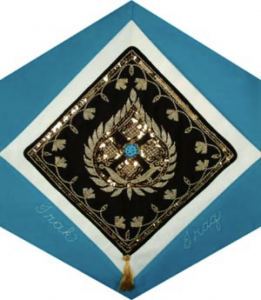Iraq

The Block
Gold embroidery shimmers against an elegant black silk background in this piece inspired by blockmaker Nawal Hassan’s vintage hachmie (also known as hashimi). These traditional Iraqi tunic gowns are worn in a variety of colours and are customarily embellished with symbolic motifs. On the block, gold-stitched sheaves of wheat and date palm represent the rich soil along the Tigris and Euphrates valley. Four squares in the centre surround a turquoise stone, which is worn as a protective amulet to ward off evil spirits. The squares symbolize shanashil (from a Persian word meaning ‘veranda’), which in its original form was a type of closed room. As an architectural style, shanashils are square houses featuring elaborately carved wooden verandas and balconies on the upper floors. They can be found in many city centers in Iraq.
Cultural Profile
Situated at the northern tip of the Persian Gulf, Iraq is one of the largest countries in the Middle East (slightly larger than Newfoundland). It was once known as Mesopotamia (the cradle of civilization), meaning ‘the land between the rivers,’ because of its position between the Tigris and Euphrates. It was also the site of the Hanging Gardens of Babylon––one of the Seven Wonders of the ancient world––built by King Nebuchadnezzar II for his wife. Iraq’s population is made up primarily of Arabs, although the country is also home to several other ethnic groups, the largest of which is the Kurds. The official language is Arabic, which has many dialects.
Family unity and honour are greatly valued in Iraq. Children are cherished and catered to, but are taught at an early age to respect their elders. Correcting their behaviour is considered to be the responsibility of extended family members and neighbours as well as the parents.
Iraq possesses a rich cultural diversity that is reflected in folk costumes, food, dress, and domestic architecture. There is a strong artistic tradition and most artworks include geometric or floral designs, since the depiction of the human figure is forbidden in Islamic art. The country is known for fine craftsmanship evidenced in their ceramics, carpets and their skilled calligraphy. Copper smithing has been done for millennia. Some pieces dating back 4,000 years have been discovered.
Iraqi hand-woven rugs are prized possessions, passed down from one generation to the next. However, the survival of this trade is in jeopardy as less and less Iraqis can afford the high cost of purchasing the labour-intensive hand-made rugs. The embroidered wedding rugs of Southern Iraq, unique to this country, feature floral, animal, human and geometric shapes embroidered on hand-woven backgrounds. Southern Iraq’s marshland, known as the Mesopotamian marshes, is also home to the traditional technique of mudhief (reed house building). This tradition nearly vanished after the marshes were dammed and dried up in the 1990s. Efforts are now underway to restore the area and preserve the unique way of life of the Madan people.
The Kurds in Iraq are known for their weaving traditions, especially their rugs. Their carpets are so durable that they are called ‘iron rugs’. The Kurds from the Jaff region are known for their woven bags.
Traditional Iraqi music includes the maqam, which dates back at least 400 years old, and uses fiddles, the dulcimers and percussion to accompany poetry, creating haunting musical pieces.
Iraqis have been coming to Canada since the early 1900s. Their numbers were small until the 1980s when many came as refugees. Early settlers were labourers who worked hard to expand their entrepreneurial activities. After World War II many arrived with higher educational and occupational qualifications, seeking work in professional and other white-collar careers. Most settled in the urban areas of Québec, Ontario, and Alberta. Their numbers reached 49,000 according to the 2011 census. At present, only two percent of the Arab ethnic population in Canada is of Iraqi origin, but by maintaining links with their ancestral heritage through Arabic food, language, music and dance, they share their culture with other Canadians.
Sponsor: Ulla Kuhlmann
